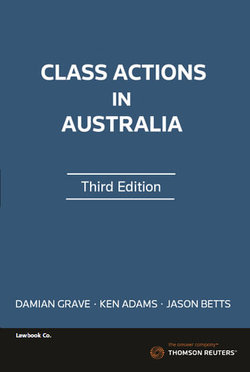Addressing the wide-ranging developments since the Second Edition published in 2012, the authors continue to cover class action litigation fully, from commencement through choice of forum, opting-out, conduct, trial, settlement, costs and funding.
New developments considered include:
- The latest empirical information on Australia’s class actions regimes.
- New chapter covering the important area of product liability class actions.
- Litigation funding – significant growth since 2012, and related developments, are considered in detail, including:
- court scrutiny of funding arrangements, including the reasonableness of the claimed commission,
- the journey of “common fund orders” from the Full Federal Court decision in Money Max (2016) to the High Court decision in Brewster (2019), and subsequent judicial consideration, and
- legislative changes including the Corporations Amendment (Litigation Funding) Regulations 2020 (Cth) and the introduction of contingency fees in Victoria from 1 July 2020.
- Growth of shareholder class actions is examined, including:
- implications of the 2019 Myer decision for listed companies’ disclosure obligations,
- market-based causation, and
- analysis and proof of loss.
- Courts’ approach to competing class actions, and their role in managing multiplicity, including the 2018 Full Federal Court decision in GetSwift (2018).
- Implications of the High Court decision in Timbercorp Finance (2018) relating to ‘Anshun estoppel’.
- Law reform focus on class actions, including:
- the 2018 ALRC report Integrity, Fairness and Efficiency – An Inquiry into Class Action Proceedings and Third-Party Litigation Funders,
- the 2018 VLRC report Access to Justice: Litigation Funding and Group Proceedings, and
- the Commonwealth Parliament’s 2020 inquiry into litigation funding and the regulation of the class action industry.
- Courts’ approach when considering settlement approval, including:
- scrutiny of legal fees,
- litigation funding commissions, and
- merits of proposed settlements.
- Consideration of the courts’ power and discretion to order “class closure”, and the possible impacts of these decisions on approaches to settlement of class actions.
- Coverage and analysis of insurance issues arising in class actions, including availability of insurance coverage, role of insurers and insurance in class action proceedings and market developments in this area.
Elegantly and clearly written, Class Actions in Australia Third Edition is an essential guide for any legal practitioner involved with, or interested in, class action litigation.






Share This Book: